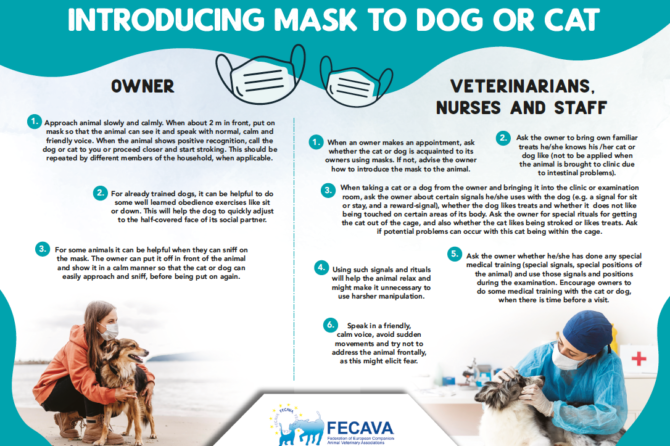
Introducing Mask to Dog or Cat
Owner
- Approach animal slowly and calmly. When about 2 m in front, put on mask so that the animal can see it and speak with normal, calm and friendly voice. When the animal shows positive recognition, call the dog or cat to you or proceed closer and start stroking. This should be repeated by different members of the household, when applicable.
- For already trained dogs, it can be helpful to do some well learned obedience exercises like sit or down. This will help the dog to quickly adjust to the half-covered face of its social partner.
- For some animals it can be helpful when they can sniff on the mask. The owner can put it off in front of the animal and show it in a calm manner so that the cat or dog can easily approach and sniff, before being put on again.
Veterinarians, nurses and staff
- When an owner makes an appointment, ask whether the cat or dog is acquainted to its owners using masks. If not, advise the owner how to introduce the mask to the animal.
- Ask the owner to bring own familiar treats he/she knows his /her cat or dog like (not to be applied when the animal is brought to clinic due to intestinal problems).
- When taking a cat or a dog from the owner and bringing it into the clinic or examination room, ask the owner about certain signals he/she uses with the dog (e.g. a signal for sit or stay, and a reward-signal), whether the dog likes treats and whether it does not like being touched on certain areas of its body. Ask the owner for special rituals for getting the cat out of the cage, and also whether the cat likes being stroked or likes treats. Ask if potential problems can occur with this cat being within the cage.
- Using such signals and rituals will help the animal relax and might make it unnecessary to use harsher manipulation.
- Ask the owner whether he/she has done any special medical training (special signals, special positions of the animal) and use those signals and positions during the examination. Encourage owners to do some medical training with the cat or dog, when there is time before a visit.
- Speak in a friendly, calm voice, avoid sudden movements and try not to address the animal frontally, as this might elicit fear.
Produced by FECAVA Animal Behaviour and Welfare Working Group.
Leave a reply
Leave a reply